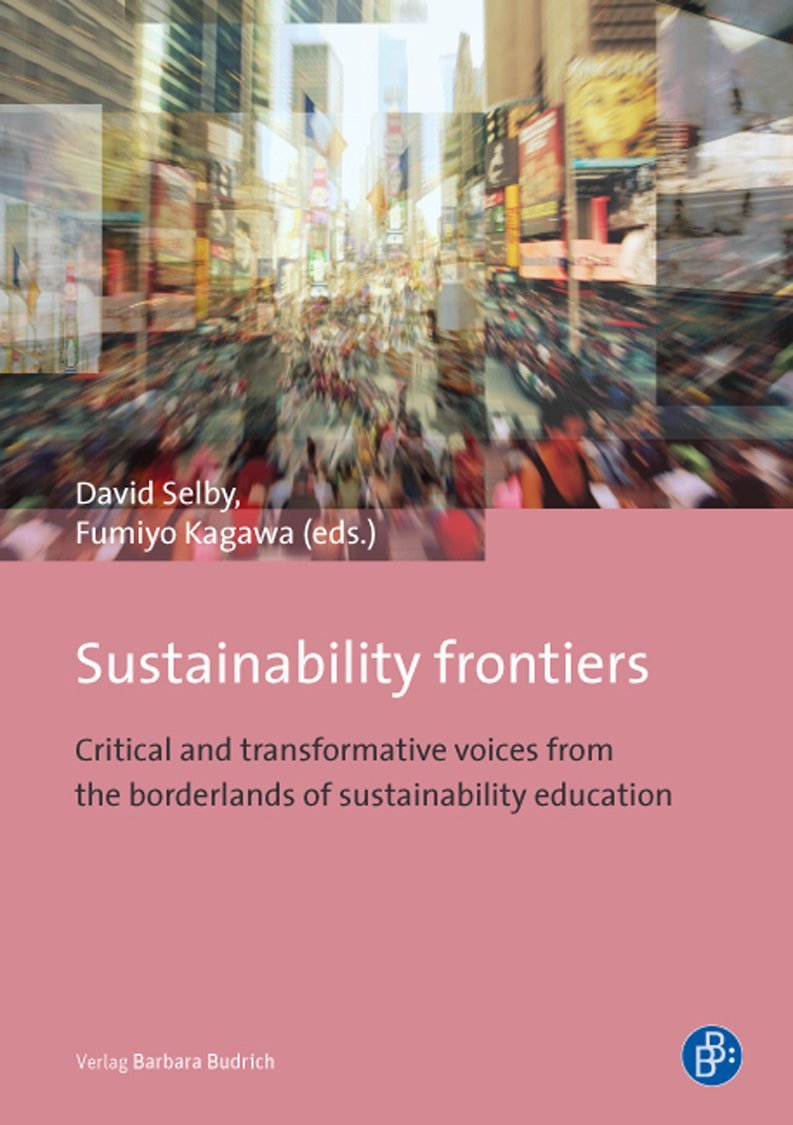
Sustainability Frontiers: Critical and Transformative Voices from the Borderlands of Sustainability Education. By David Selby & Fumiyo Kagawa (eds.), Barbara Budrich, Opladen, 2015.
Education for sustainable development – the educational offshoot of the concept of ‘sustainable development’ – has rapidly become the predominant educational response to the global environmental crisis. This collection of fourteen essays applies a critical lens to the field and finds it wanting in many regards. Generally accepting of the prevailing neo-liberal agenda, education for sustainable development still largely shies away from confronting market globalization and rampant consumerism as key factors and forces in fomenting an unsustainable world. It also continues to prioritize technological, scientific, and policy dimensions, paying insufficient heed to social and axiological (values) domains. Pivotally, education for sustainable development is more or less underpinned by a mechanistic and reductionist worldview rather than a holistic or ecological paradigm and, as such, often advances problem as cure in its proposals and programs. Its discourse is overwhelmingly occidental, occluding the voice and experience of the South. The book’s contributors – from Asia, Australasia, Europe and North and South America – speak from the borderlands of sustainability-related education, a fertile, generative zone rich in insights, ideas and proposals for transformative education, a zone free of the unsustainable ‘business as usual’ tenor and assumptions of much of education for sustainable development.
To download the book flyer, click here.
To place an order for the book, click here.
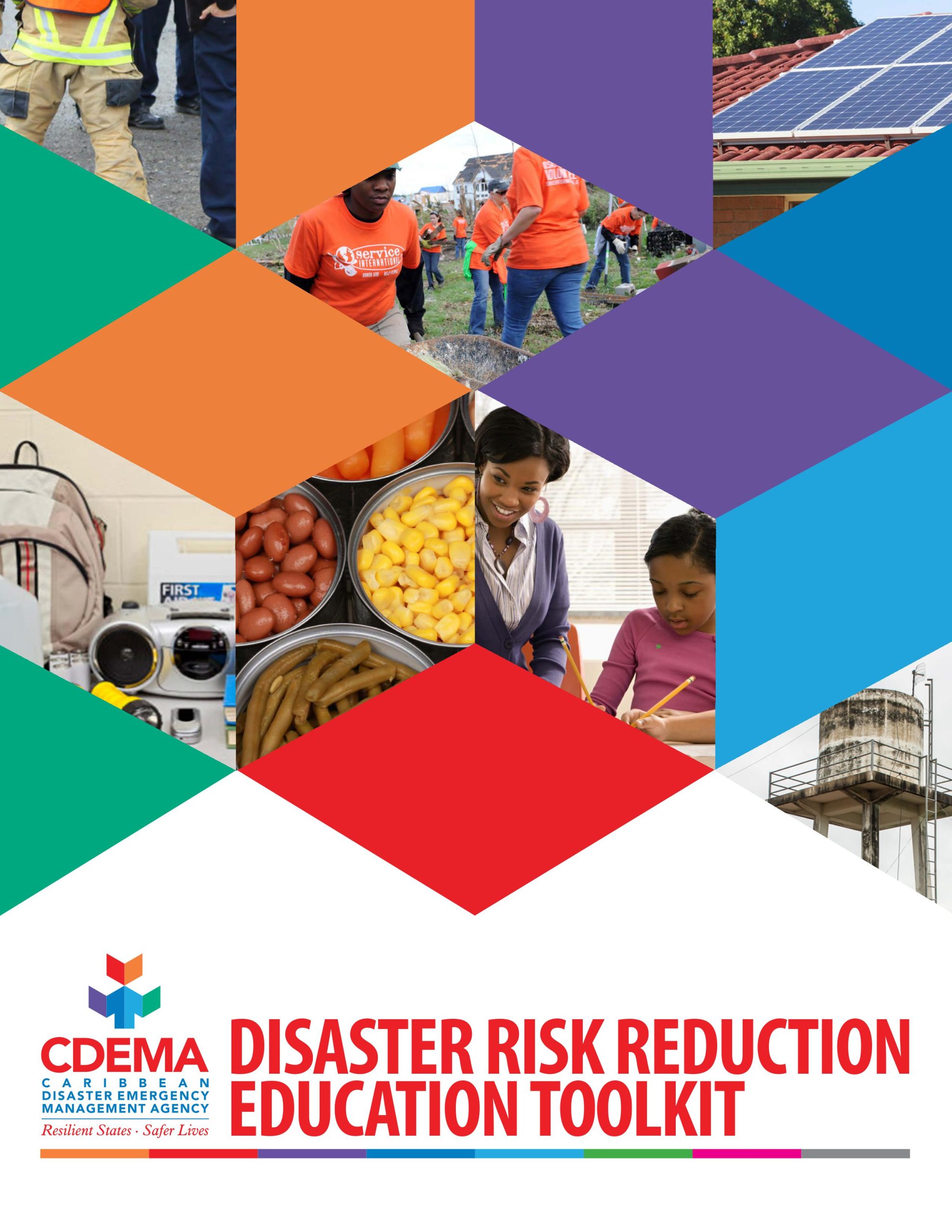
Disaster Risk Reduction Education Toolkit. By David Selby & Fumiyo Kagawa. CDEMA. St. Michael, 2014, 210pp.
The five introductory sections give guidance on how to use the toolkit, explain key ideas in disaster risk reduction, lay out what the authors see as the five dimensions of disaster risk education, show how disaster risk reduction can be incorporated across the school curriculum, and give practical guidance on learning and teaching approaches. There follows a 140-page section containing a wide range of primary and secondary level learning activities with sub-sections of: introductory and awareness-raising activities, activities for disaster preparedness and risk reduction (covering climatological, geo-seismic and human-induced hazards), climate change activities, activities for resilience building, and activities for post-disaster contexts. The toolkit ends with sections on student assessment, resource lists on other practical guides and on sources of disaster risk information for the teacher, and, finally, a collection of PowerPoint slides to use with the activities.
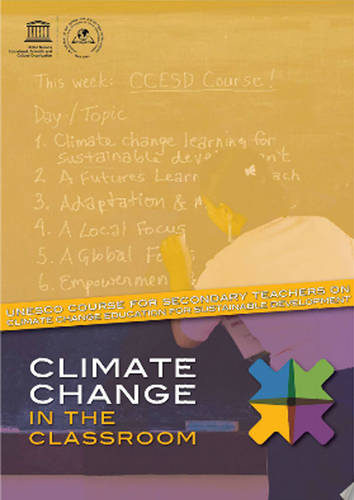 Climate Change in the Classroom: UNESCO Course for Secondary Teachers on Climate Change Education for Sustainable Development. By David Selby & Fumiyo Kagawa, UNESCO, Paris, 2013
Climate Change in the Classroom: UNESCO Course for Secondary Teachers on Climate Change Education for Sustainable Development. By David Selby & Fumiyo Kagawa, UNESCO, Paris, 2013
Climate Change in the Classroom offers a six-day teacher education program on climate change education and is designed to give teachers the confidence, understanding and skills to in turn help their students understand the causes, drivers and consequences of climate change and equip them with the necessary skills and dispositions to contribute to climate change adaptation and mitigation. The program takes climate change education beyond the science classroom by also looking at ethical, social, economic, cultural and political dimensions of climate change. There is much, therefore, for the social studies, languages, and creative and performing arts teachers in the activities and materials. The activities are suitable for both pre-service and in-service teacher education. The teaching pack opens with a Start Menu with a click-on facility to the following materials: Course Framework and Overview; Daily Course Material for Teacher Educators (with step-by-step daily programs, detailed description of activities, support materials, PowerPoint slides for training inputs); bespoke Regional Resource Packs for Africa, Asia, Europe and North America, and Small Island States; Daily Classroom Materials for Teachers (activities for back in classroom linked to the theme of each training day). Climate Change in the Classroom is the first online teacher education pack for secondary teachers. It uses Flash-based software to support a flipbook format providing an on-screen textbook page-turning experience. The pack is the outcome of a March to June 2011 Climate Change Education for Sustainable Development (CCESD) UNESCO consultancy undertaken by Sustainability Frontiers.
http://unesdoc.unesco.org/images/0021/002197/219752e.pdf (the full PDF version)
In Portuguese
http://www.unesco.org/ulis/cgi-bin/ulis.pl?catno=229737&set=00542A6FA7_1_246&gp=1&lin=1&ll=1
In French
https://unesdoc.unesco.org/ark:/48223/pf0000234887
 Sustainability Education: Perspectives and Practice Across Higher Education. Edited by Paula Jones, David Selby & Stephen Sterling. Earthscan, London, 2010. 364pp.
Sustainability Education: Perspectives and Practice Across Higher Education. Edited by Paula Jones, David Selby & Stephen Sterling. Earthscan, London, 2010. 364pp.
How do we equip learners with the values, knowledge, skills, and motivation to help achieve economic, social and ecological well being? How can universities make a major contribution towards a more sustainable future? Amid rising expectations on HE from professional associations, funding bodies, policy makers, and undergraduates, and increasing interest amongst academics and senior management, a growing number of higher education institutions are taking the lead in embracing sustainability. This response not only includes greening the campus but also transforming curricula, teaching and learning.
This book explains why this is necessary and – crucially – how to do it, distilling out the curriculum contribution, actual and potential, of a wide range of disciplinary areas to sustainability.
The first part of the book provides background on the current status of sustainability within higher education, including chapters discussing interdisciplinarity, international perspectives and pedagogy. The second part features thirteen case studies from lecturers in diverse disciplines, describing what has worked, how and why – and what hasn’t. Whilst the book is organized by traditional disciplines, the authors and editors emphasize transferable lessons and interdisciplinary opportunity so that readers can learn from examples outside their own area in embedding sustainability within their own curricula and teaching.
Subject areas covered include: geography, environmental and earth sciences, nursing/health, law, dance, drama, music, engineering, media and cultural studies, art and design, theology, social work, economics, languages, education, business and built environment.
To place an order for the book, click here.
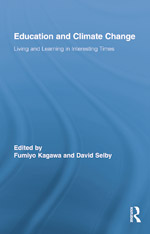 Education and Climate Change: Living and Learning in Interesting Times. Edited by Fumiyo Kagawa & David Selby. Routledge Research in Education Series, New York, 2010, 260pp.
Education and Climate Change: Living and Learning in Interesting Times. Edited by Fumiyo Kagawa & David Selby. Routledge Research in Education Series, New York, 2010, 260pp.
There is widespread consensus in the international scientific community that climate change is happening and that abrupt and irreversible impacts are already set in motion. What part does education have to play in helping alleviate rampant climate change and in mitigating its worst effects? In this volume, contributors review and reflect upon social learning from and within their fields of educational expertise in response to the concerns over climate change. They address the contributions the field is currently making to help preempt and mitigate the environmental and social impacts of climate change, as well as how it will continue to respond to the ever-changing climate situation. There is a special foreword by Desmond Tutu, Archbishop Emeritus of Cape Town.
To place an order for the book, click here.
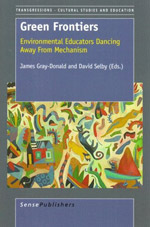 Green Frontiers: Environmental Educators Dancing Away from Mechanism. Edited by James Gray-Donald & David Selby. Transgressions: Cultural Studies and Education Series, Sense Publishers, Rotterdam, 2008, 296pp.
Green Frontiers: Environmental Educators Dancing Away from Mechanism. Edited by James Gray-Donald & David Selby. Transgressions: Cultural Studies and Education Series, Sense Publishers, Rotterdam, 2008, 296pp.
Environmental education has reached an interesting crossroads. There has never before been such a media attention on hard-to-grasp issues such as climate change, not has there ever been such scientific understanding and agreement about the varied aspects of the environmental crisis, the loss of diversity, and the health effects of human-made toxins and pollutants. In addition, there has never been so much high quality research within environmental education, with new journals flourishing in Canada, Australia, and South Africa to give just a few examples. Yet, despite all this knowledge and attention, there has not been a significant shift in the way the economy operates, the way governments govern or the way people live. Consumption of resources continues to increase and these patterns continue to be closely correlated with levels of waste, pollution, environmental ill-health, and social injustice. This book showcases the work and thinking of environmental educators who are concerned about the residual mechanism within their field, the guiding symbol of the web of life notwithstanding. The notion of web recognizes interaction between all elements in a system but falls short of recognizing the flow of the whole through the system and its parts. The notion of dance is used here to convey this fundamental, yet oft overlooked, dimension to wholeness.
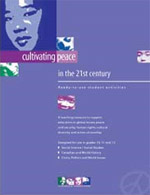 Cultivating peace in the 21st century. By James Gray-Donald, Dick Holland, Fumiyo Kagawa & David Selby. Classroom Connections, Toronto, 2002. 59pp.
Cultivating peace in the 21st century. By James Gray-Donald, Dick Holland, Fumiyo Kagawa & David Selby. Classroom Connections, Toronto, 2002. 59pp.
A downloadable teaching resource for grades 10, 11 and 12 to support education in global issues, peace and security, human rights, cultural diversity and active citizenship, this publication received the Canadian Peace Education Award in 2003. Recognizing and building on the idea that peace is a process by employing interactive and dialogic learning approaches, the resource seeks to educate about and for peace through seven lessons that also educate in or through peace on account of the learning dynamics set in train.
To obtain access to the book, click here.

 In the Global Classroom: 1 and 2. By Graham Pike & David Selby. Pippin Publishing, Toronto, 1999 and 2000, 256pp and 260pp. New editions, with a whole new chapter of climate change activities and a range of critical sustainability and futures activities, are to be published later in 2010!
In the Global Classroom: 1 and 2. By Graham Pike & David Selby. Pippin Publishing, Toronto, 1999 and 2000, 256pp and 260pp. New editions, with a whole new chapter of climate change activities and a range of critical sustainability and futures activities, are to be published later in 2010!
These two books represent a major compendium of global education classroom activities covering all curriculum areas and grade levels. Providing an impressively diverse range of activities, the books are organized thematically to coincide with topics frequently addressed in social studies, languages, science, health, technology and other curriculum areas. They are ideally tailored to serve as rich resources for pre and in-service teacher training. Each book begins with an exploration of global education theory and then, chapter by chapter, offers a wealth of tried and tested, lively, practical and challenging activities designed to develop critical thinking, empathy and the skills of communication and negotiation and supported by teaching case studies and photocopiable stimulus material. In Book 1 there are activity chapters on: interconnections; environment and sustainability; health; perceptions, perspectives and cross-cultural encounters; technology; futures. In Book 2 there are chapters on: peace; rights and responsibilities; equity; economics, development, and global justice; mass media. The books are available in Czech, Japanese, Portuguese and Russian translation. Click on the book cover images to order from Pippin Publishing in Canada. To order from the UK distributor, Gazelle Book Services, go to: http://www.gazellebookservices.co.uk/ISBN/088751085X.htm
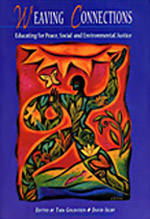 Weaving Connections: Educating for Peace, Social and Environmental Justice. Edited by Tara Goldstein & David Selby. Sumach Press, Toronto, 2000, 400pp.
Weaving Connections: Educating for Peace, Social and Environmental Justice. Edited by Tara Goldstein & David Selby. Sumach Press, Toronto, 2000, 400pp.
This collection of fourteen essays by Canadian educators documents social, political and environmental educational philosophies and approaches, developed in the last thirty or so years of the twenty-first century, that are directed towards equity, social justice, peacefulness and earth awareness. The developments are seen as under serious threat within an increasingly pervasive culture within the educational system of compliance with marketplace usefulness. The second goal of the book is, therefore, to challenge directions in Canadian school reform – directions that promote ‘back to basics’, a centralization of control, a conformist conception of citizenship, corporate intrusion, insidious deprofessionalization of the teacher, ‘doing more with less,’‘learning for earning’ and performance measurability. Such orientations are explicitly and implicitly critiqued as denying of human potential, liable to exacerbate rather than heal social tensions, and deepen estrangement from nature. The collection opens and closes with a conversation between the two editors.
